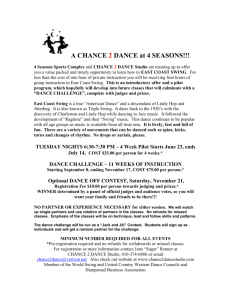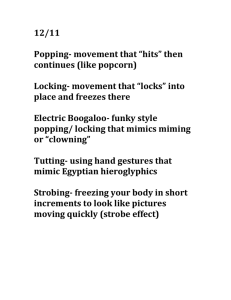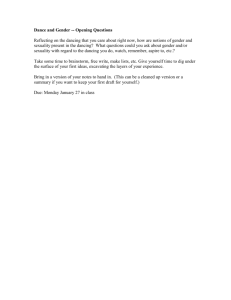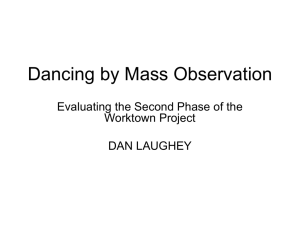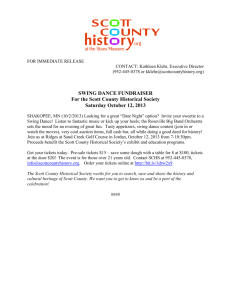Swing Dance Power Point
advertisement
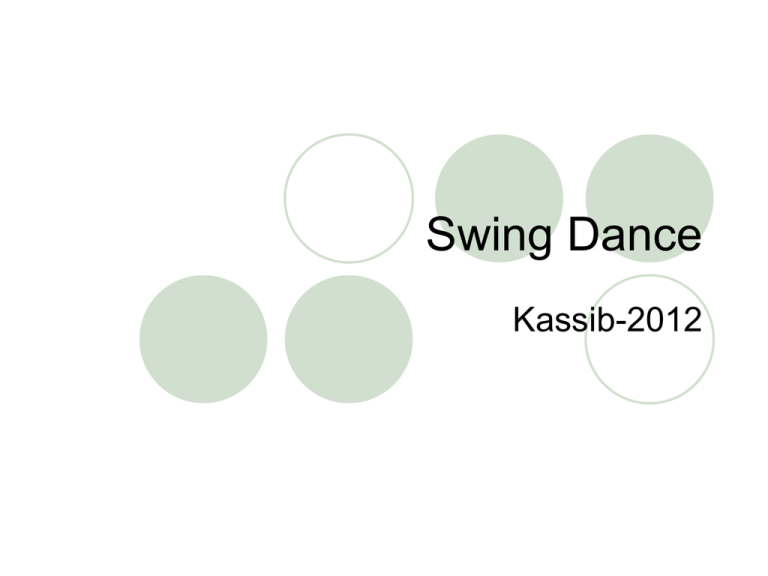
Swing Dance Kassib-2012 Types of Swing Dance 1. 2. 3. 4. 5. 6. 7. Lindy Hop Balboa Charleston Shag East Coast Swing Shim-Shim Big Apple History of Swing & Jazz Music Jazz had two major offshoots: Swing and Blues. Blues Music was close to the original feel of the Spiritual with its emphasis on storytelling vocals. Swing Music had vocals too, but concentrated much more on the interweave of coordinated Instruments. The most popular dance in America is usually inspired by the most popular music (e.g., Disco music created Disco dancing). As Jazz Music became popular, suddenly America had its first dance craze! With New Orleans as the "Cradle of Jazz", Dixieland music, Ragtime, Blues, and Spiritual music had been developing in the South for a long time before and after the Civil War. As freed slaves migrated in search of opportunity, they moved up the mighty Mississippi to St Louis, then on to Chicago as well. Many musicians moved from the South to Harlem, New York City. Harlem is given credit as the Birthplace of Swing music, the Charleston, and then Lindy Dancing as well during the 20's. However back in the 20s, there were no traditions in partner dancing to draw from. People danced freestyle as they looked for ways to express themselves and from this came the CHARLESTON, which fit the music to a Tee. Charleston A spirited dance characterized by swinging feet & outward heel kicks, the Charleston probably goes back to Africa. Its American origins began on a small island off the South Carolina coast. World War I put everything on hold, but in the 20s the stage was set to see the Charleston break loose with passionate abandon as America's first dance craze. America had won the war, the Yanks had returned from Europe, the economy was booming, and now everyone wanted to party! In the beginning dancers went to the end of their arms, which then stretched like rubber bands to snap the partners back towards one another. After their arms got sore enough, footwork like the backstep, the twist, the ball-change, & the rock step became ways to stop momentum without having to use arm tension. Recurring footwork began to develop as a natural way to keep their balance at the end of a move. For example, some basketball players know the exact number of steps a particular move takes & the foot they must start with; one extra step will allow a defender to catch up. Dance systems developed in the same way as dancers discovered precise footwork to gracefully accomplish their moves with an economy of effort. Lindy Gets It’s Name! As Swing music developed in the 20s, so did a new dance, which was part Charleston, part, something else. One night shortly after Charles Lindbergh's historic solo flight across the Atlantic, a huge dance marathon was in progress at the Savoy. A very talented dancer was doing jumps, leaps, & somersaults followed by sky-scraping acrobatic lifts with his partner. Impressed by the young man's skill, a reporter asked him what he was doing. "Hey, man, take a look, I'm flying! I'm doing the Lindy!" The airborne image clearly fit. Called the LINDY HOP in next day's newspaper write-up, America had its first Swing dance. Interestingly, many of today’s Lindy patterns include all sorts of variations on the Charleston. It was the addition of the newer "Swinging" patterns plus the acrobatics and jumping that signified the emergence of this newer dance form. Inspired by the music, it almost seemed like the dancers were indeed ready to fly! Swing Dancing & The Jitterbug The term SWING DANCING came along five years after the LINDY HOP got its name. The term JITTERBUG also appeared in the early 30s. "The Call of the Jitterbug", but its original meaning was far removed from dancing. Back then the "Jitterbug" had darker connotations. A big band musician, had a trombone player who trembled from alcohol abuse ("bug juice jitters"). Not long after the song came out, the meaning of "Jitterbug" shifted to become a slang word for "hepcat" (a musician who plays swing or jazz) and the type of music he played (i.e., Jitterbug music). "Jitterbug" shifted again to signify a person who moved his body well while dancing ("Shake, Rattle, & Roll"). By the late 30s the "Jitterbug" had joined "Lindy" to become yet another popular name for Swing dancing. WW II was the major reason that Swing dancing became an American Dance The radio had already made Swing music enormously popular but the spread of the dancing lagged far behind. Back in the 30's there was no television to spread images of the dancing around the country quickly. However by the start of the war, all of the large cities had become Jitterbug hotbeds. When GIs, sailors, and flyers enlisted to fight for our country, they were sent to major ports for a temporary stay before departure. These service men & women headed straight for the USO dance halls since dancing was by far the major form of recreation. As the 40s began, many GIs from all parts of the country now saw the Lindy/Jitterbug for the first time. Once they saw it however, they didn’t waste any time learning how since dancing was the quickest way to break the ice in an age when time was very precious. Swing dancing had arrived! The Lindy also acquired yet another name, "Jive", the British slang word for "Jazz". Although its impact on England was the strongest, as one country after another was liberated, the Lindy appeared in France, Italy, the Philippines, Japan, and yes, Germany. American culture had found a very peculiar way to make its Swing Dance international! Modern Swing
